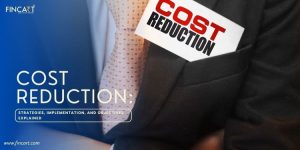Running and growing a business needs money. But where does this money come from? Generally, a company has two main options: It can sell shares to raise money from investors, which is called equity financing, or it can take a loan from a financial institution, which is called debt financing. This second method (borrowing money) is what we call leverage.
So what is leverage in financial management? In simple terms, leverage definition can be understood as using borrowed funds to boost the potential return of a business or investment. It allows a company to invest with less of its own profits.
There are different kinds of leverage, but the main two types are financial and operating leverage. Here, we’re going to be talking about what is operating leverage, how it works, and why it matters.
What Is Operating Leverage?
Let’s kick off with operating leverage meaning. There are multiple definitions of it, but the idea boils down to this: Operating leverage is a metric that shows how a company’s fixed costs can help boost its profits when sales go up. Every business has two kinds of costs:
- Fixed costs: As the name implies, these costs stay the same no matter what. If your sales go up or down, these costs must be paid. Examples include things like rent, salaries, or machinery maintenance.
- Variable costs: These expenses depend on production level, i.e., how many units you produce or sell. Raw materials, commissions, and labour are all examples of variable costs.
So, what do you mean by operating leverage? It’s a ratio that tells us about the relationship between these two types of costs and how they impact a company’s operating profit as sales change.
A company with high fixed costs and lower variable costs is said to have high operating leverage, and a small increase in sales can lead to a much bigger leap in profit. That’s because its fixed costs are already covered, so most of the revenue turns into profit.
For instance, let’s say a small-scale company produces garments mostly using temporary workers. The fixed costs would include expenses such as factory rent, salaries of permanent staff, and machinery and equipment costs, and the variable costs would include fabric, packaging material, transportation per unit, and wages paid to temporary labour. These costs go up or down depending on how many garments the company manufactures.
So, if the company produces 500 shirts this month and 1,000 shirts the next, the fixed costs stay the same, but the variable costs change as they also need more fabric and labour to produce them. The more this company relies on these variable costs, the lower its operating leverage.
But if the same company invests in machines to automate stitching which increases fixed costs, its operating leverage will rise. They still have to pay for fabric and transportation as they produce more, but due to greater fixed costs, small changes in sales volume will have a much bigger impact on its profit margins.
Operating leverage is an important measure when it comes to business financial planning. It indicates how a company’s costs are structured and how they can balance fixed and variable costs to optimise profits.
How Operating Leverage Works
We’ve seen that the degree of operating leverage is affected by a company’s fixed costs. The higher it is relative to variable costs, the higher the operating leverage. Here’s another example to clarify the concept of the degree of operating leverage. A car manufacturing company has the following major expenses:
- Fixed costs: Factory lease, salaries of engineers, and machinery maintenance.
- Variable costs: Raw materials and logistics.
For manufacturing companies in general, the fixed costs far outweigh the variable costs. It’s the same case here. Suppose one month, the demand for this company’s cars was high. It sold 10,000 units in a month and made a good profit.
The next month, due to an economic slump, the sales went down drastically. It sold only 500 cars. In the good, as well as bad months, the company still had to pay the same fixed costs – factory rent, staff salaries, machinery maintenance, etc. These aren’t going to change just because the company sold fewer cars.
While it’s true that the company didn’t need to buy as many raw materials, the savings weren’t enough to offset the steep decline in revenue (as variable costs are much lower comparatively). This is the risk that comes with a high degree of operating leverage.
You still need to cover the high fixed costs even if you do not produce or sell as much of the product in a given period.
How to Calculate Operating Leverage
Operating leverage can be calculated by dividing the percentage change in EBIT (Earnings Before Interest and Taxes) by the percentage change in sales. Thus,
Degree of Operating Leverage (DOL) = % change in EBIT / % change in sales (revenue)
This is the primary way to calculate DOL. There are many other ways of doing so derived from the same concept, such as:
DOL = Contribution Margin / Operating Income
Here,
- Contribution Margin = Total Sales Revenue – Variable Costs
- Operating Income = Contribution Margin – Fixed Costs
Here’s how to calculate operating leverage using % change in operating income and sales:
DOL = Change in Operating Income / Change in Sales
There are several implications of DOL:
1. It tells us about a company’s breakeven point
When a company has high operating leverage, it means it heavily relies on fixed costs. It needs to sell more units to break even and start making a profit. On the other hand, a company with a lower DOL has a lower break-even point.
2. It shows the degree to which profits react to changes in sales
A high DOL means that small changes in revenue can lead to big changes in profit, for better or worse. This can be a great thing when the demand for a product is high as a slight increase in sales can cause profits to skyrocket. But since it is a double-edged sword, a dip in sales can hurt profits sharply as well.
3. It guides investors in risk assessment
High DOL companies might offer higher returns to investors but they also carry greater risk. Low DOL companies tend to grow slower, but they offer more stability. Though this should not be followed as a rule as DOL varies from industry to industry. Investors should look at DOL within the context of the specific industry to make decisions.
Of course, there’s also the fact that DOL is just one piece of the puzzle. Other factors, such as historic revenue, debt levels, market demand, and future plans also matter. That’s why speaking with a wealth management advisor can go a long way.
They can help you assess companies more holistically and guide you toward investments, be it stocks, portfolio management services, or an SIP investment plan, that match your financial goals and risk tolerance.
Operating Leverage Formula
The primary operating leverage formula is:
Degree of Operating Leverage = % change in EBIT / % change in sales
Businesses employ financial consultants and analysts who use DOL to analyse the company’s cost structure, forecast sales scenarios, and assess how sensitive profits are to changes in revenue. Using the degree of operating leverage helps companies make better decisions about product or service pricing, expansion, investment in technology, cost control, and more.
High and Low Operating Leverage Calculation Example
Example 1:
Let’s say when a company increases its revenue by 10%, its earnings increase by 20%. To calculate, we’ll use the operating leverage formula:
DOL = % change in EBIT / % change in sales (revenue)
DOL = 20% / 10%
DOL = 2
This means that with every 1% increase in sales, the company’s operating income goes up by 2%.
Example 2:
A business makes sales worth Rs. 1 crore. Its fixed costs are Rs. 30 lakh and variable costs are Rs. 50 lakh. We can calculate the degree of operating leverage using:
DOL = Contribution Margin / Operating Income
Where,
- Contribution Margin = Total Sales Revenue – Variable Costs
- Operating Income = Contribution Margin – Fixed Costs
Calculating contribution margin:
CM = Total Sales Revenue – Variable Costs
CM = Rs 1,00,00,000 – Rs. 50,00,000
CM = Rs. 50 lakh
Calculating operating income
OM = Contribution Margin – Fixed Costs
OM = Rs. 50,00,000 – Rs. 30,00,000
OM = Rs. 20 lakh
DOL = Contribution Margin / Operating Income
DOL = Rs. 50 lakh / Rs. 20 lakh
DOL = 2.5
The DOL suggests that a 1% increase in sales leads to a 2.5% increase in EBIT.
How to Interpret Operating Leverage by Industry
One should be careful when assessing the DOLs of different companies, as operating leverage varies significantly across industries. You can’t compare the DOL of a software company with that of an electronics manufacturer as the proportion of fixed and variable costs in their business models is very different.
For example, a video game developer would invest heavily in creating the game by hiring designers and developers and spending years building the product. These costs are largely fixed. Once the game is developed, they can sell the game physically or online which means the cost of distributing it is minimal.
So, if the game takes off and the sales rise, most of the revenue after the break-even point turns into profit. This is because the company has high operating leverage. If the game flops, the cost of development will be hard to recoup, which tells you about the risk associated with high DOL.
On the other hand, a retail chain operates with lower operating leverage. Of course, it does have some fixed costs like store and warehouse rent and staff salaries, but most of its expenses are variable. These costs rise and fall with how much sales they make.
If you want to compare the DOLs between two companies, make sure they are in the same industry. In such a case, the company with the lower DOL is generally more stable and less risky, as its profits are not that sensitive to changes in sales.
If you have a higher risk tolerance, you can look at the company with the higher DOL as it would have more potential for profit growth.
Conclusion
Operating leverage is a ratio that shows us a company’s cost structure, and how it balances fixed costs with variable costs. It helps analysts and investors understand how sensitive a company’s operating income is to changes in its sales. If the degree of operating leverage is high, it means the company has high fixed costs.
This can lead to bigger profits when demand is high, but it also comes with the risk of making losses when demand goes down. A lower degree of operating leverage suggests the company is using a more flexible cost structure and will give steady results even during periods of uncertainty.




